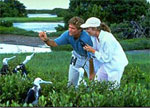 Barbuda is one of those very few islands in the Caribbean that remains--and probably will remain for some time--so undeveloped as to seem positively deserted at times. With the exception of the guests of the island's small number of accommodations, the population seems largely to consist of the graceful Fregata magnificens, or frigate bird. As the birds possess a marked preference for the northwest lagoon, Barbuda's seemingly endless white and pink sand beaches are left to the peaceful wanderings of those lucky enough to sojourn here
Barbuda is one of those very few islands in the Caribbean that remains--and probably will remain for some time--so undeveloped as to seem positively deserted at times. With the exception of the guests of the island's small number of accommodations, the population seems largely to consist of the graceful Fregata magnificens, or frigate bird. As the birds possess a marked preference for the northwest lagoon, Barbuda's seemingly endless white and pink sand beaches are left to the peaceful wanderings of those lucky enough to sojourn here
Activities on Barbuda are appropriately relaxed, including beachcombing (on the northeastern Atlantic coast), fishing and hunting and, at the island's resorts, golf, tennis, snorkeling, diving, or simply soaking up the sun and the calm. Points of interest include the Frigate Bird Sanctuary, the truly noteworthy pink and white sand beaches, and an abundance of shipwrecks and beautiful reefs. Barbuda can be reached easily from Antigua, either by air (a 20-minute flight, twice daily) or by boat (in three hours). The island is home to the luxurious K-Club, Coco Point Lodge and Hotel Palmetto resorts, as well as to a number of other hotels and comfortable guest houses.
 Barbuda's Frigate Bird Sanctuary is located in the island's northwestern lagoon and is accessible only by boat. The sanctuary contains over 170 species of birds and is home to over 5,000 frigate birds. Fregata magnificens, the most aerial of waterbirds, possesses the largest wingspan (four to five feet) in proportion to its body size of any bird in the world. It is also known as the man o' war bird, and the comparison to warships is a particularly apt one--with its superior size and flight capabilities, the frigate bird harasses less agile flyers like pelicans, egrets, and cormorants until they drop their catch. The male frigate is marked by its red throat pouch, which it can inflates as part of its courtship behaviour and as a defensive display. Courting takes place in the fall, and chicks hatch late in the year.
Barbuda's Frigate Bird Sanctuary is located in the island's northwestern lagoon and is accessible only by boat. The sanctuary contains over 170 species of birds and is home to over 5,000 frigate birds. Fregata magnificens, the most aerial of waterbirds, possesses the largest wingspan (four to five feet) in proportion to its body size of any bird in the world. It is also known as the man o' war bird, and the comparison to warships is a particularly apt one--with its superior size and flight capabilities, the frigate bird harasses less agile flyers like pelicans, egrets, and cormorants until they drop their catch. The male frigate is marked by its red throat pouch, which it can inflates as part of its courtship behaviour and as a defensive display. Courting takes place in the fall, and chicks hatch late in the year. 








